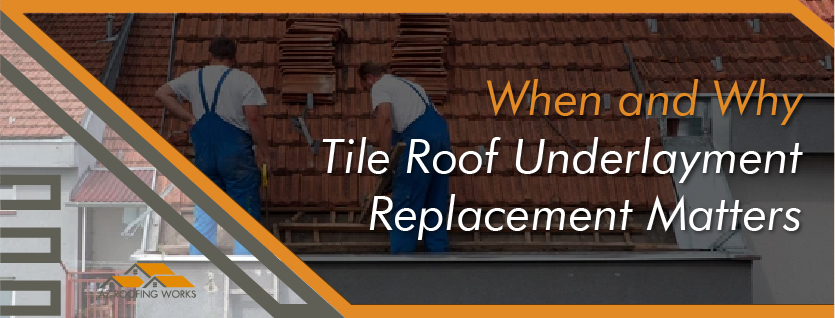When and Why Tile Roof Underlayment Replacement Matters
Your roof is the unsung hero of your home.
It protects you from the blazing Arizona sun and occasional desert rain day in and day out.
Among the various roofing materials available, tile roofs stand out for their durability and timeless aesthetic.
However, even the most robust tile roofs require attention and maintenance over time.
If your roof is in need of some tender love and care, we have you covered.
Keep reading to discover what you need to know about tile roof underlayment replacement in the Greater Phoenix area.
Understanding Tile Roof Underlayment
Before we jump into the why and when, let’s quickly grasp the role of underlayment in a tile roof.
The underlayment is the hidden layer between the roof deck and the tiles themselves.
It serves as an additional barrier, protecting your home from water infiltration and ensuring your roof’s longevity.
Over time, exposure to the sun, rain, and other weather elements can take a toll on this underlayment, necessitating replacement.
When Does Tile Roof Underlayment Replacement Matter?
One of the primary indicators that it might be time to replace your tile roof underlayment is the age of the roof itself.
As your roof ages, so does its underlayment.
Most experts recommend replacing underlayment every 20-25 years, depending on the material used.
If your tile roof is approaching or has surpassed this timeline, it’s an opportune moment to consider underlayment replacement.
Pay attention to visible signs of wear and tear.
Cracked, curled, or missing tiles may indicate that the underlayment beneath is also compromised.
Additionally, if you notice water stains on your ceiling or walls, it could be a sign that the underlayment is no longer providing adequate protection.
Regular inspections, especially after severe weather events, can help catch these signs early.
If you’re experiencing leaks or water intrusion, it’s a clear sign that something is amiss with your roof.
The underlayment might be damaged or failing, allowing water to seep through.
Addressing a roof leak promptly is crucial to prevent further damage to your home’s interior and the structural integrity of the roof.
Tile roofs are designed to withstand a variety of weather conditions, but extreme events can still take a toll.
High winds, heavy rains, and severe storms can accelerate the wear and tear on your roof’s underlayment.
After such events, it’s wise to inspect your roof for any potential damage and consider underlayment replacement if necessary.
Why Tile Roof Underlayment Replacement Matters
The underlayment protects the structural integrity of your roof.
It acts as a protective barrier, preventing water from infiltrating the roof deck and causing damage to the underlying structure.
Regular replacement ensures that this barrier remains effective, safeguarding your home for years to come.
A compromised underlayment can lead to water leaks, resulting in damage to your home’s interior.
Water stains on ceilings, mold growth, and damaged insulation are just a few of the potential consequences.
By replacing the underlayment when necessary, you’re proactively preventing costly repairs to the interior of your home.
Just as regular oil changes extend the life of your car, timely underlayment replacement can significantly extend the lifespan of your tile roof.
Investing in maintenance now can save you from the need for premature roof replacement in the future.
It’s a cost-effective strategy to ensure the long-term health of your roofing system.
An intact underlayment contributes to the overall energy efficiency of your home.
It acts as an additional layer of insulation, helping regulate indoor temperatures.
By ensuring that your underlayment is in top condition, you contribute to a more energy-efficient home, reducing heating and cooling costs.
Now, let’s address the elephant in the room; the cost.
While the cost of tile roof underlayment replacement varies based on factors such as the size of your roof, the type of underlayment material, and local labor rates, it’s essential to view it as an investment rather than an expense.
Guide to Tile Roof Underlayment Replacement
Replacing the underlayment of a tile roof is a significant project. Some homeowners with roofing experience may feel comfortable tackling certain roofing projects.
It’s generally advisable to hire a professional for this type of work.
Their services contribute to the following:
- Expertise
- Safety procedures
- Quality Workmanship
- Warranty
- Efficiency
- Code Compliance
- Prevention of further damage
When Roof Underlayment Fails
When a roof’s underlayment fails, it can lead to various issues.
Here are some potential consequences:
The primary function of the underlayment is to provide a waterproof barrier.
If it fails, water can penetrate through the roof, causing leaks.
Water infiltration can lead to the growth of mold and the rotting of wood and other materials in the roof structure.
Mold can pose health risks and compromise indoor air quality.
The long-term effects of water damage can weaken the roof structure, including:
- Rafters
- Trusses
- Decking
This may lead to sagging, warping, or even partial collapse.
It may damage paint, plaster, and other finishes.
Water infiltration poses an electrical hazard risk and increases the likelihood of short circuits or fires.
Tile Roof Maintenance Tips
A well-maintained tile roof can last 50 years or more.
Regular inspections, including checking the underlayment, play a crucial role in achieving this longevity.
Here are some roof care tips to consider:
Conduct regular inspections to identify and address any issues.
Clean gutters regularly. Remove any moss or algae growth to prevent damage and maintain the appearance of the roof.
Promptly replace any cracked or damaged tiles to prevent water infiltration.
Inspect and replace flashings and sealants as needed to maintain water-tightness.
Consider hiring professionals for periodic inspections to assess the condition of the roof.
Secure Your Tile Roof’s Longevity Today
We can agree that tile roof underlayment replacement matters.
It safeguards your roof’s structural integrity and prevents water damage.
When your roof’s underlayment fails, it can lead to serious problems and safety issues.
AZ Roofing Works says experience is not measured by a number – but by proven results!
When you partner with us, you get high-quality and affordable roofing services.
If you live in Mesa, Chandler, Scottsdale, Tempe, Gilbert, or any other Metro Phoenix location, contact us today.
Considering a Phoenix roof repair contractor? Tile roof underlayment replacement is crucial for structural integrity. AZ Roofing Works is ready to help you! Contact us today, either online or call our office directly, our friendly staff members are standing by at (602) 283-3383.






